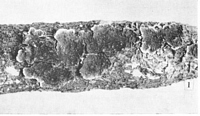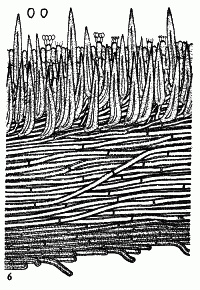|
 Hymenochaete patelliformis Hymenochaete patelliformis
BiostatusPresent in region - Indigenous. Endemic
Images (click to enlarge)
Caption: Pl. 2, fig. 1. Hymenochaete patelliformis G.H.Cunn. x 1. Umbonate-sessile pilei. | 
Caption: FIG. 6. Hymenochaete patelliformis G.H.Cunn. Transverse section x 500; spores x 1000 |
Article: Cunningham, G.H. (1957). Thelephoraceae of New Zealand. XIV. The genus Hymenochaete. Transactions of the Royal Society of New Zealand 85(1): 1-51.
Description: Hymenophore annual, coriaceous, brittle, pileate or resupinate; pilei consisting of numerous
orbicular, patelliform colonies with broad resupinate base and narrow reflexed margins, some
arranged in linear areas to 15 cm long, or sessile-umbonate with free margins, 2-25 mm
diameter, reflexed portions to 5 mm broad, surface radiately sulcate or even, with narrow
radiate bands of chestnut and umber brief hairs, soon glabrous. Hymenial surface at first
umber or date-brown, soon chocolate, irregularly tuberculate, at length deeply creviced in the
central area; margin thinning out, lobed, fulvous, to 1 mm wide. Context pallid ferruginous,
130-200 µ thick, of parallel hyphae radiately arranged and embedding masses of crystals
beneath the setal layer, cortext of parallel cemented hyphae, reddish-brown; hyphal system
dimitic; skeletal hyphae 3-3.5 µ diameter, walls 0.5 µ thick, golden yellow, scantily branched,
septate, tending to collapse; generative hyphae 2-2.5 µ diameter, walls 0.2 µ thick, hyaline,
branched, septate. Setal layer 60-90 µ deep, composed of 3-5 rows of overlapping setae,
densely compacted, arising from the subhymenium and a deeply coloured zone of intertwined
hyphae lying below it; setae projecting to 25 µ, subulate with acuminate apices, often bent at
the base, 30-56 x 5-7 µ, walls naked, reddish-brown, lumina narrow. Hymenial layer to 30 µ
deep, a dense palisade of basidia and paraphyses. Basidia subclavate, 10-12 x 3.5-4 µ, 4-spored; sterigmata arcuate, slender, to 4 µ long.
Paraphyses subclavate, of the same diameter
but shorter than the basidia. Spores obovate, 2.5-3 x 1.5-2 µ, walls smooth, hyaline, 0.1 µ
thick.
Habitat: HABITAT: On bark of dead branches associated with a coarse pocket rot.
Distribution: DISTRIBUTION: New Zealand.
Notes: Readily recognized by the colour and shape of pilei, colliculose or tuberculate surface, thin
brittle context with the cortex composed of cemented parallel hyphae, small setae, basidia,
and minute spores.
Pilei at first are orbicular and patelliform or umbonate-sessile with free plane margins. They
may remain thus or margins become reflexed to form narrow pilei with the surface scantily
clothed in short hairs. Later, colonies may merge to form linear areas which may attain a
length of 15 cm. At first the hymenial surface is date-brown and finely colliculose; soon it
changes to a rich chocolate with bright fulvous margins. Finally specimens become almost
black with concolorous margins. Crevices at first appear near the centre, but as plants age
extend until fructifications become coarsely segmented. The context is firm though brittle,
and contains masses of crystals. Setae are small and crowded into a setal layer the thickness
of which increases from periphery to centre. Setae are frequently bent at an angle and
occasionally may be found embedded in the context. Spores are the smallest seen in species
of the genus.
|